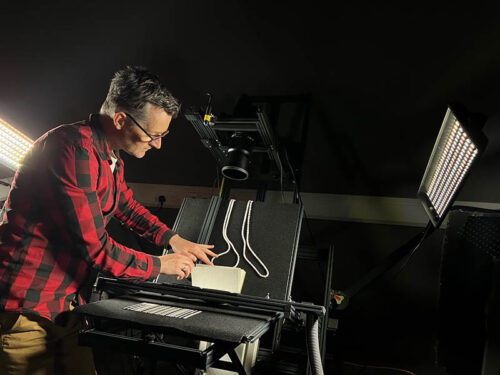
I was delighted to take on the challenge of helping photograph the University’s collection of notebooks of geologist Sir Charles Lyell, and there’s a bit more to photographing 300 notebooks than one might imagine. The Cultural Heritage Digitisation Service is a fantastic team of people, and quickly welcomed me onboard. Prior to this posting, I’ve enjoyed a varied background, including photographing the contents of National Trust for Scotland castles as part of a major digitisation project Reveal, plus Polar and Northern Lights photography aboard expedition cruise ships.
The appeal of heritage photography is that we get to work with completely unique materials each day. In cataloguing the seven storeys of Craigievar Castle or various wings of Leith Hall, I had to work quickly to digitise every item in each property. One could find oneself photographing oversized pieces of furniture or weapon collections one moment, then Bonnie Prince Charlie’s buttons the next. Photographers cultivate special leaning skills in order to delicately negotiate the diminishing flights of spiral stairs, for magically transporting their lighting equipment into far-flung turrets above the clouds. By contrast, rare book photography is something of a different game.
I’ve found the most notable peculiarity to be working almost, but not quite, in two dimensions. Due to their historical importance and particular value, the Lyell notebooks cannot be photographed using a more conventional book-scanning system, but their capture is achieved by placing them into a specially designed conservation ‘cradle’. This minimises any potential strain on the book’s spine. The cradle boasts a number of bells and whistles: a copy-lighting setup with banks of LED lights produces flat, even illumination; a vacuum bar holds pages open; a laser-assisted system generates pin sharpness at the plane of focus. It’s always surprising how quickly depth of field vanishes with a macro lens!
To attain the highest quality images, the studio is equipped with PhaseOne medium format cameras and a 120mm macro lens. Archiving very large 16bit TIFF files means that all the image data is retained for use during subsequent processing (as compared with JPEG files, which discard the vast majority of information). Archival imaging is all about quality, so standardisation of colour and illumination are paramount. There is a complex daily setup procedure to ensure that each individual notebook will match with the larger Lyell set, and shooting each volume with a colour card helps to control this. Tethered capture to PC monitors is achieved via a very nifty foot pedal, leaving our hands free to make continual adjustments to the cradle and the notebook while progressing through the volume. And how welcome would such a pedal have been during the finger-freezing Arctic nights of Northern Lights photography?
On completion of the photography, there is a string of workflow processes to edit and upload the TIFF image files. The images undergo encounters with asset management programmes, Layout Wizzards and catalogue records along their journey through cyberspace. They will experience multiple checks and procedures, by humans and not-so-humans, who collaborate to implement various tricks of the trade, and deliver them to their final destination in the format of a fully-digitised Sir Charles Lyell notebook! Why not ‘leaf through’ some of Sir Charles Lyell’s notebooks and other intriguing assets in the University’s collections at https://images.is.ed.ac.uk/luna/servlet/UoEsha~5~5
John Sikorski, Project Photographer
Be First to Comment